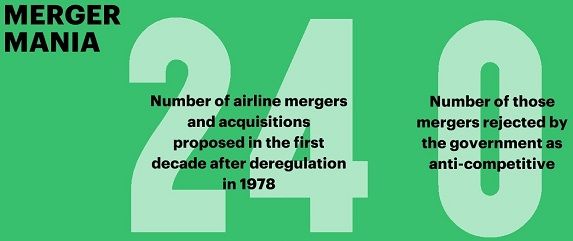Accompanying Barbara Peterson‘s critical take on airline consolidation in Conde’ Nast Traveler is an interesting infographic that’s worth perusing.

One item in particular stood out to me as likely incorrect, but that turns out to be accurate, and offers some interesting historical perspective on the current American-US Airways deal.
When I saw the above graphic, and that claim that ‘0’ mergers had been rejected by the government as anti-competitive I knew that was wrong — because the Department of Justice announced that it would sue to stop the proposed United-US Airways merger in July 2001.
Except the infographic is right, reading the statistic on the left it refers to ‘the first decade after deregulation’ so only extends through 1988. And the statistic on the right — 0 mergers fought by the government — is accurate is also looking only to 1988.
The implication that the government has never fought a merger would be wrong, even if they hadn’t done so between 1978 and 1988.
But it’s only ‘sort of’ wrong. Take that proposed United-US Airways merger. It turns out that United had actually soured on the deal in the year since it was announced. The troubles in the airline industry at the start of the last decade are often traced to 9/11 but the downturn actually began before that, and with the decline in industry fortunes in early 2001, United was less interested in acquiring US Airways.
Calling off the merger prior to August 1 was going to cost them a breakup fee of $50 million. But they’d also face lawsuits for reneging on the deal, something that the Justice Department’s announced opposition effectively shielded them from. It’s likely that United actually lobbied for the Justice Department to oppose their own deal for cover as they pulled out.
When the United-US Airways deal was announced in 2000, part of the package was a divestiture of slots at Washington National airport. Then, as now, the expected biggest stopper was additional consolidation at DC’s close-in airport where US Airways was already dominant (and is more so today).
American and US Airways have sought to fend off calls for divestiture of slots, arguing that transferring those slots to other airlines would end air service from the airport to smaller communities — which is likely correct, but also likely won’t matter. It’s the one pound of flesh that’s been expected to be extracted from the deal, and that was proactively even offered in the last deal that US Airways tried to do a dozen years ago.
There were concerns that the Rober Johnson-led carrier, DC Air, which was to be formed along with the United-US Airways merger wouldn’t be viable on its own. So ironically enough American was brought in on part of the proposed deal.
The rest of the infographic is worth perusing. But this one statistic, I thought, only told a part of the story.
Nonetheless, it’s true that airline mergers have generally garnered approval — but airlines have historically been a fairly unprofitable investment. Failing or near-failing businesses tend to be given a relative pass for competitive scrutiny, especially on the theory that those businesses aren’t likely to remain strong stand-alone competitors.
Opposition to the United-US Airways deal, even if prompted by lobbying by United, stands out not only as a rare exception to the rule but also as being misguided. Subsequent to failing to marge with United, of course, the airline went through two bankruptcies before merging with America West (an acquisition Doug Parker made for a pittance) and finally getting turned around. History proved that the airline wasn’t viable as a standalone carrier, after all, and is now likely to merge for a second time subsequent to that proceeding.
- You can join the 30,000+ people who see these deals and analysis every day — sign up to receive posts by email (just one e-mail per day) or subscribe to the RSS feed. It’s free. Don’t miss out!

